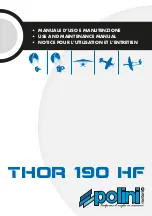
Coolant Change
• At the end of a coolant drain interval, remove the used coolant by following the
drain procedure provided in the engine service literature and re-fill with fresh
coolant.
• Note that not all drain procedures for a specific application have the ability to
drain all of the used coolant from the cooling system. For these applications, a
drain and flush process might be needed to ensure as much used coolant is
removed from the cooling system before installing new coolant. A drain and
flush process includes draining as much coolant out of the system as possible and
thoroughly flushing the system with de-ionized water or water that meets water
requirements outlined in Appendix B, Refer to section "Appendix B - General
Coolant Information".
• When new coolant is installed, circulate the system should and use a
refractometer to ensure the new coolant is not diluted with residual water from
the flush process. For example, if enough residual water is in the system, use
concentrated coolant to re-balance the concentration so the desired ratio for your
application is reached. Circulate the system and use a refractometer to recheck
the concentration. The suggested mixing ratio is 50/50 (50% antifreeze / 50%
water) for regular climate or 60/40 (60% antifreeze / 40% water) for colder
climates.
Changing Coolant Technologies
• Follow cooling system flushing recommendations outlined in Coolant Change
section.
• To ensure there is no mixing between the old technology and new technology,
full chemical analysis should be conducted.
• If possible, coordinate with your coolant supplier for additional support when
changing coolant technologies.
Cooling System Contamination
• Follow cooling system flushing recommendations outlined in Coolant Change
section.
• If a coolant system failure occurs that results in coolant contamination, a
complete cooling system flush is required. If the contamination cannot be
removed via a clean water flush, a cooling system cleaner can also be used.
Please contact the DTNA Aftermarket for available cooling system cleaning
products.
• If a cleaner is used, it is important to complete a chemical analysis to ensure
there is no interaction between the newly installed coolant and any residual
cleaner from the flush process.
• If possible, please work with the cleaner supplier for additional support when
using a cooling system cleaner.
GHG17 DD Medium Duty Operators Manual
All information subject to change without notice.
101
DDC-SVC-MAN-0192
Copyright © 2022 DETROIT DIESEL CORPORATION
















































